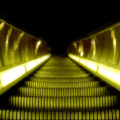"Rates." Eugene Water & Electric Board.1 2007. Eugene Water & Electric Board.
From this site, we found quotes for commercial energy rates to calculate annual energy costs of the escalator.
Stein, Benjamin, et al. Mechanical and Electrical Equipment for Buildings.
This book provided us with the means to size a motor (p. 1472) and aided us with conversions, particularly that of horsepower to watts (p. 180).
Team Otis: Walter Grondzik, Daniel Faoro, Allison Kwok. (
Presented at the COOL TOOLS workshop in
This is the inspiration of our case study. We built our project around the energy use of escalators and how they’re being under utilized.
Kwok, Alison G, and Walter T. Grondzik. The Green Studio Handbook: Environmental Strategies for Schematic Design.
The Energy Production chapter (p.183) allowed us to conclude how much the motor of the escalator is adding to the cooling load, and thus the annual energy cost.
The 2.2.1 Step (Escalator) Chain. Tsubakimoto Chain Co..
This contributed to the general mechanical information about how escalators work and the role of the step chain and its corresponding size and attachments.
General Elevator and Escalator Information. Otis Co..
0,1361,CLI1,00.html>.
This also contributed to the general knowledge listed on the appendix. This site gave us the history and components of the escalator.
2006 Buildings Energy Data Book.8 Dec. 2006. U.S. Department of Energy. 15 Mar. 2007 <http://buildingsdatabook.eren.doe.gov/>.
This site gave us the chart for total energy use of commercial buildings.



